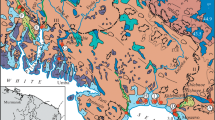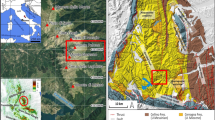Abstract
Lateroglacial landforms play a major role in the geomorphological landscape assemblage of the Karakoram Mountains. Nevertheless, in the past they have received only little attention in the glacial-geomorphological literature. In this article, the lateroglacial landscape will be presented as a geomorphological landscape unit. The Karakoram glaciers with lengths of up to 60 km are accompanied by lateroglacial sediment complexes over tens of kilometers. Besides their large horizontal distribution, they are spread over a considerable vertical range and occur between 2500 m–5000 m.
The traditional view is that primary processes of rock disintegration such as ice avalanches and freeze-thaw processes as well as glaciofluvial sediments are the main debris suppliers for the formation of lateroglacial sediment complexes. However, the investigation of the lateroglacial sediment landscape of the Karakoram glaciers showed, that firstly the secondary debris supply in form of reworking of older glacigenic deposits (Late glacial slope moraines) represents a major debris source. Secondly, the lateroglacial sediments are composed to a major part of debris supplies from the tributary valleys. In this regard, the sediment input by mudflow events accords a prominent role. Therefore a considerable proportion of the lateroglacial sediments is of non-glacial origin. This fact has to be taken into consideration regarding glacier reconstruction in recent unglaciated mountain valleys. Further on, resedimented mudflow deposits could be identified as important parent material for recent lateral moraine formation. The distribution of lateroglacial valleys (`lateral moraine valleys') was traditionally closely linked to differences in insolation, which are in the subtropical latitude very high (`ablation valleys'). Therefore the S-faced valley flank was seen as the favourable location for lateroglacial valleys. However, field observations on more than 20 glaciers in the Karakoram Mountains proved that lateroglacial valleys occur in all exposures, and can be even absent in S-exposure. Topographical factors seem to be more important than insolation differences for the distribution pattern. Only the distribution of `true ablation valleys' can be regarded as a result of insolation differences. In fact, they can act as initial form for the formation of lateral moraine valleys.
Similar content being viewed by others
References
Bobek, H. 1935: Die jüngere Geschichte der Inntalterrasse und der Rückzug der letzten Vergletscherung im Inntal. Jahrbuch der Geologischen Bundesanstalt, Band 85, 135–189. Wien.
Church, M. & J.M. Ryder 1972: Lateroglacial sedimentation, a consideration of fluvial processes conditioned by glaciation. Geological Society of America Bulletin 83, 3059–3072.
Dainelli, G. 1922: Relazione Scientifiche della Spedizone italiana de Filippi, nell'Himalaia, Caracorum e turchestan Cinese (1913–14) serei II. Resultati geologici e geografici, vol. 3, Bologna.
Derbyshire, E., Li Jijun, Perrot, F.A., Xu Shuying & R.S. Waters 1984: Quaternary glacial history of the Hunza valley Karakoram Mountains, Pakistan. Miller, K.J. (ed.), The International Karakoram Project., vol. 2 Cambridge: Cambridge University Press, 456–495.
Eggers, H. 1961: Moränenterrassen im Wallis: Morphologische Untersuchungen zu spätglazialen Formen und Vorgängen in den Schweizer Alpen. Freiburger Geographische Arbeiten, Heft 1, 127 pp.
Flaig, W. 1938: Das Gletscherbuch. Rätsel und Romantik, Gestalt und Gesetz der Alpengletscher. Leipzig, 196 pp.
Flint, R.F. 1971: Glacial and Quaternary geology. New York, John Wiley and Sons, Inc.
Haserodt, K. 1989: Zur pleistozänen und postglazialen Vergletscherung zwischen Hindukusch, Karakorum und West-Himalaya. Haserodt, K. (ed.), Hochgebirgsräume Nordpakistans im Hindukusch, Karakorum undWest-Himalaya: Beiträge zur Natur-und Kulturgeographie. Beiträge und Materialien zur Regionalen Geographie, 2, 181–233, Berlin.
Heim, A. 1932: Bergsturz und Menschenleben. Fretz und Wasmuth Verlag A.G., Zürich, 218 pp.
Heim, A. 1933: Minya Gongkar. Forschungsreise ins Hochgebirge von Chinesisch-Tibet. Bern, Berlin 1933.
Hewitt, K. 1989: The altitudinal organisation of Karakoram geomorphic processes and depositional environments. Zeitschrift für Geomorphologie, Supplementband 76, 9–32.
Hewitt, K. 1993: Altitudinal organization of Karakoram geomorphic processes and depositional environments. J.F. Shroder, jr. (ed.), Himalaya to the Sea. Geology, geomorphology and the Quaternary. Routledge Press, London, 159–183.
Hewitt, K. 1999: Quaternary Moraines vs Catastrophic Rock Avalanches in the Karakoram Himalaya, Northern Pakistan. Quaternary Research vol. 51, Number 3, 220–237. Academic Press.
Humlum, O. 1978: Genesis of layered lateral moraines: implications for paleoclimatology and lichenometry. Geografisk Tidsskrift 77, 65–72, Kopenhagen.
Iturrizaga, L. 1999a: Die Schuttkörper in Hochasien – Eine geomorphologische Bestandsaufnahme und Typologie postglazialer Hochgebirgsschuttkörper im Hindukusch, Karakorum und Himalaya. Göttinger Geographische Abhandlungen, Band 106, 326 pp.
Iturrizaga, L. 1999b: Typical debris accumulation forms and formations in High Asia. A glacial-history-based concept of the origin of Postglacial debris accumulation landscapes in subtropical high mountains with selected examples from the Hindu Kush, the Karakoram and the Himalayas. M. Kuhle (ed.), GeoJournal, Tibet and High Asia V, vol. 47, nos 1–2, 277–339.
Iturrizaga, L. 2000: The distribution of debris accumulations in the Rakhiot Valley, Nanga Parbat-N-Side (Pakistan). Miehe, G. & Zhang Yili (eds.), Environmental Changes in High Asia. Proceedings of an International Symposium at the University of Marburg. Marburger Geographische Schriften, Heft 135, 28–39.
Iturrizaga, L., in press: Transglacial sediments in the Karakoram Mountains. A case study from the Shimshal Valley. In: Kreutzmann, H. (Ed.). Karakoram in Transition.
Iturrizaga, L. in press: Der Pumari Chhish-Gletscherausbruch (Karakorum / Pakistan): Geomorphologische Ñberprägungen des lateroglazialen Sedimentationsumfeld durch kurzzeitige Gletscherveränderungen. Terra Nostra, (DEUQUA 2002 in Berlin, ‘Mensch-Klima-Landschaft’).
Jamieson, T.F. 1874: On the last stage of the Glacial Period in North Britain. Geol. Soc. London Quart. Jour., vol. 30, 317–338.
Jordan, E. 1991: Die Gletscher der bolivianischen Anden. Erdwissenschaftliche Forschung. Franz Steiner Verlag Stuttgart, 365 pp.
Jorstad, F.A. 1957: Ablationstäler und Ufertäler. Petermanns Geographische Mitteilungen 101, 98–100.
Kalvoda, J. 1992: Geomorphology record of the Quaternary orogeny in the Himalaya and the Karakoram. Developments in Earth Surface Processes 3, 315 pp.
Kamp, U. 1999: Jungquartäre Geomorphologie und Vergletscherung im östlichen Hindukusch, Chitral, Nordpakistan. Inst. für Geographie der Techn. Univ. Berlin, 254 pp.
Kick, W. 1956: Der Chogo-Lungma-Gletscher im Karakorum. Zeitschrift für Gletscherkunde und Glazialgeologie, Band 3, 335–347.
Kick, W. 1989: The decline of the last Little Ice Age in High Asia compared with that in the Alps. Oerlemans, J. (ed.), Glacier Fluctuations and Climatic Change, 129–142.
Klebelsberg, R.v. 1938: Visser's Karakorum-Glaziologie. In: Zeitschrift für Gletscherkunde, Band 26, Heft 3/4, 307–320.
Klebelsberg, R.v. 1950: Das Silltal bei Matrei. Aus seiner jüngsten geologischen Vergangenheit. Beiträge zur Heimatkunde von Matrei am Brenner. Schlern-Schriften84, Universitätsverlag Wagner, 76–86, Innsbruck 1950.
Kuhle, M. 1988: The Pleistocene Glaciation of Tibet and the Onset of the Ice Ages – An Autocycle Hypothesis. In: GeoJournal 17, 581–595.
Kuhle, M. 1991: Glazialgeomorphologie. Wissenschaftliche Buchgesellschaft Darmstadt. 213 pp.
Kuhle, M. 1994: Present and Pleistocene Glaciation on the North-Western margin of Tibet between the Karakorum Main ridge and the Tarim Basin Supporting the Evidence of a Pleistocene Inland Glaciation in Tibet. M. Kuhle (ed.), GeoJournal, vol. 33, Tibet and High Asia III, no. 2/3, 133–272.
Kuhle, M. 1998: Reconstruction of the 2.4 Million km2 Late Pleistocene Ice Sheet on the Tibetan Plateau and its Impact on the Global Climate. Quaternary International, vol. 45/46, 71–108.
Kuhle, M. 2001: Glaciogeomorphological reconstruction of the maximum Ice Age (LGM) glaciation of the Central-and South Karakorum, the heights of its glacier levels and ice thicknesses as well as several lowest prehistoric ice margin positions in the Hindukush, Himalaya and in East-Tibet near the Minya Konka-massif. GeoJournal (ed. by M. Kuhle), Tibet and High Asia (VI). Glacio-geomorphology and prehistoric Glaciation in the Karakorum and Himalaya.
Mayewski, P.A. & P.A. Jeschke 1979: Himalayan and Trans-Himalayan glacier fluctuations since AD 1812. Arctic and Alpine Research 11, 267–287.
Meiners, S. 1997: Historical to Postglacial glaciation and their differentiation from the Late Glacial period on examples of the Tian Shan and the N.W. Karakorum. M. Kuhle (ed.), GeoJournal 42, vol. 2–3, Tibet and High Asia IV, 259–302.
Odell, N.E. 1925: Observations on the Rocks and Glaciers of Mount Everest. The Geographical Journal, vol. 66, 289–335.
Oestreich, K. 1906: Die Täler des nordwestlichen Himalaya. Ergänzungsheft Nr. 155 zu Petermanns Geographische Mitteilungen, 106 pp. Gotha, Justus Perthes.
Oestreich, K. 1911/12: Der Tschochogletscher in Baltistan. Zeitschrift für Gletscherkunde 6, 1–30.
Owen, L.A. & E. Derbyshire 1989: The Karakoram glacial depositional system. Derbyshire, E. & L.A. Owen (eds.), Zeitschrift für Geomorphologie, Supplementband 76, 33–74.
Schwarzgruber, R. 1939: Die Gangotrigruppe (westlicher Garhwal-Himalaja). Zeitschrift des Deutschen Alpenvereins 70, 21–31.
Visser, P.C. 1928: Von den Gletschern am Obersten Indus. Zeitschrift für Gletscherkunde, vol. 16, 169–229.
Visser, P.C. 1938: Glaziologie. Visser, Ph.C. & J. Visser Hooft (eds.): Wissenschaftliche Ergebnisse der Niederländischen Expeditionen in den Karakorum und die angrenzenden Gebiete in den Jahren 1922, 1925 und 1929/30. Band II, 215 pp.
Wiche, K. 1960: Klimamorphologische Untersuchungen im westlichen Karakorum. Verhandlungen des Deutschen Geographentages, Band 32, 190–203. Franz Steiner Verlag
Winkler, S. 1996: Frührezente und rezente Gletscherschwankungen in Ostalpen und West-/Zentralnorwegen. Ein regionaler Vergleich von Chronologie, Ursachen und glazialmorphologischen Auswirkungen. Trierer Geographische Studien, Heft 15, 580 pp.
Workman, F.B. 1905: From Srinagar to the sources of the Chogo Lungma Glaciers. Geographical Journal 25, 245–268.
Author information
Authors and Affiliations
Rights and permissions
About this article
Cite this article
Iturrizaga, L. Lateroglacial valleys and landforms in the Karakoram Mountains (Pakistan). GeoJournal 54, 397–428 (2001). https://doi.org/10.1023/A:1021365416056
Issue Date:
DOI: https://doi.org/10.1023/A:1021365416056




